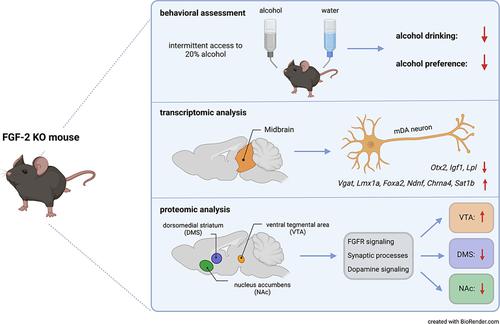当前位置:
X-MOL 学术
›
Eur. J. Nerosci.
›
论文详情
Our official English website, www.x-mol.net, welcomes your feedback! (Note: you will need to create a separate account there.)
A dual-omics approach on the effects of fibroblast growth factor-2 (FGF-2) on ventral tegmental area dopaminergic neurons in response to alcohol consumption in mice
European Journal of Neroscience ( IF 3.4 ) Pub Date : 2024-01-07 , DOI: 10.1111/ejn.16234 Leonie Hose 1, 2 , Alina Katharina Langenhagen 1, 3 , Ekaterini Kefalakes 1 , Theresa Schweitzer 4, 5 , Sabrina Kubinski 1 , Segev Barak 6 , Andreas Pich 4, 5 , Claudia Grothe 1, 2
European Journal of Neroscience ( IF 3.4 ) Pub Date : 2024-01-07 , DOI: 10.1111/ejn.16234 Leonie Hose 1, 2 , Alina Katharina Langenhagen 1, 3 , Ekaterini Kefalakes 1 , Theresa Schweitzer 4, 5 , Sabrina Kubinski 1 , Segev Barak 6 , Andreas Pich 4, 5 , Claudia Grothe 1, 2
Affiliation

|
Harmful alcohol consumption is a major socioeconomic burden to the health system, as it can be the cause of mortality of heavy alcohol drinkers. The dopaminergic (DAergic) system is thought to play an important role in the pathogenesis of alcohol drinking behaviour; however, its exact role remains elusive. Fibroblast growth factor 2 (FGF-2), a neurotrophic factor, associated with both the DAergic system and alcohol consumption, may play an important role in DAergic neuroadaptations during alcohol abuse. Within this study, we aimed to clarify the role of endogenous FGF-2 on the DAergic system and whether there is a possible link to alcohol consumption. We found that lack of FGF-2 reduces the alcohol intake of mice. Transcriptome analysis of DAergic neurons revealed that FGF-2 knockout (FGF-2 KO) shifts the molecular fingerprint of midbrain dopaminergic (mDA) neurons to DA subtypes of the ventral tegmental area (VTA). In line with this, proteomic changes predominantly appear also in the VTA. Interestingly, these changes led to an altered regulation of the FGF-2 signalling cascades and DAergic pathways in a region-specific manner, which was only marginally affected by voluntary alcohol consumption. Thus, lack of FGF-2 not only affects the gene expression but also the proteome of specific brain regions of mDA neurons. Our study provides new insights into the neuroadaptations of the DAergic system during alcohol abuse and, therefore, comprises novel targets for future pharmacological interventions.
中文翻译:

双组学方法研究成纤维细胞生长因子 2 (FGF-2) 对小鼠腹侧被盖区多巴胺能神经元响应酒精消耗的影响
有害的酒精消费是卫生系统的主要社会经济负担,因为它可能是重度饮酒者死亡的原因。多巴胺能 (DAergic) 系统被认为在饮酒行为的发病机制中发挥着重要作用;然而,其确切作用仍然难以捉摸。成纤维细胞生长因子 2 (FGF-2) 是一种神经营养因子,与 DAergic 系统和饮酒相关,可能在酗酒期间的 DAergic 神经适应中发挥重要作用。在这项研究中,我们旨在阐明内源性 FGF-2 对 DAergic 系统的作用以及是否与饮酒存在可能的联系。我们发现缺乏 FGF-2 会减少小鼠的酒精摄入量。 DAergic 神经元的转录组分析表明,FGF-2 敲除 (FGF-2 KO) 会将中脑多巴胺能 (mDA) 神经元的分子指纹转变为腹侧被盖区 (VTA) 的 DA 亚型。与此一致,蛋白质组变化也主要出现在 VTA 中。有趣的是,这些变化导致 FGF-2 信号级联和 DAergic 通路以区域特异性方式发生改变,而自愿饮酒仅对其产生轻微影响。因此,FGF-2的缺乏不仅影响基因表达,而且影响mDA神经元特定脑区的蛋白质组。我们的研究为酗酒期间 DAergic 系统的神经适应提供了新的见解,因此包含了未来药物干预的新目标。
更新日期:2024-01-07
中文翻译:

双组学方法研究成纤维细胞生长因子 2 (FGF-2) 对小鼠腹侧被盖区多巴胺能神经元响应酒精消耗的影响
有害的酒精消费是卫生系统的主要社会经济负担,因为它可能是重度饮酒者死亡的原因。多巴胺能 (DAergic) 系统被认为在饮酒行为的发病机制中发挥着重要作用;然而,其确切作用仍然难以捉摸。成纤维细胞生长因子 2 (FGF-2) 是一种神经营养因子,与 DAergic 系统和饮酒相关,可能在酗酒期间的 DAergic 神经适应中发挥重要作用。在这项研究中,我们旨在阐明内源性 FGF-2 对 DAergic 系统的作用以及是否与饮酒存在可能的联系。我们发现缺乏 FGF-2 会减少小鼠的酒精摄入量。 DAergic 神经元的转录组分析表明,FGF-2 敲除 (FGF-2 KO) 会将中脑多巴胺能 (mDA) 神经元的分子指纹转变为腹侧被盖区 (VTA) 的 DA 亚型。与此一致,蛋白质组变化也主要出现在 VTA 中。有趣的是,这些变化导致 FGF-2 信号级联和 DAergic 通路以区域特异性方式发生改变,而自愿饮酒仅对其产生轻微影响。因此,FGF-2的缺乏不仅影响基因表达,而且影响mDA神经元特定脑区的蛋白质组。我们的研究为酗酒期间 DAergic 系统的神经适应提供了新的见解,因此包含了未来药物干预的新目标。



























 京公网安备 11010802027423号
京公网安备 11010802027423号